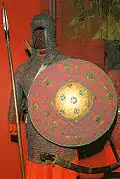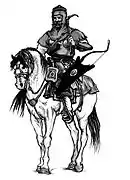Armoured companion
Armoured companion (Polish: Towarzysz pancerny Polish: [tɔˈvaʐɨʂ panˈtsɛrnɨ], plural: towarzysze pancerni) was a medium-cavalryman in 16th to 18th century Poland, named after their chainmail armor. These units were the second-most-important (and successful) cavalry in the Polish-Lithuanian army, after the hussars.
| Towarzysz pancerny | |
|---|---|
 | |
| Allegiance | |
| Type | cavalry |
| Role | Standing professional military |
| Equipment | war hammer, Mace (bludgeon), hatchet, sabre spear Lance |
Most pancerni were recruited from the middle or lower classes of the Polish (or Lithuanian) nobility. They were organized into companies, with each company (Polish: chorągiew or rota) consisting of 60 to 200 horsemen.
Arms and Armour
They used chainmail or bechter armour to protect the upper body, vambrace sometimes with gauntlets, secretes (rarely lobster-tailed pot helmets), buckler shields, Polish sabre, composite bow, pistols, and carbine. Earlier companies would sometimes be equipped with a horseman's pick, mace, or lance. During the rule of king John III Sobieski, polearms became compulsory.
During the Middle Ages, under the rule of Mieszko I and Bolesław I the Brave, the name pancerni applied to the members of the duke's retinue. They were the wealthiest warriors in the Polish army, and as such, they could afford to wear sophisticated armour, most commonly chainmail. Their weapons included arming swords, axes, spears, shields, and strait bows.
 Armour and equipment of a Polish towarzysz pancerny, in the late 17th century at Muzeum Wojska Polskiego
Armour and equipment of a Polish towarzysz pancerny, in the late 17th century at Muzeum Wojska Polskiego
 Towarzysz pancerny by Dariusz T. Wielec
Towarzysz pancerny by Dariusz T. Wielec Pocztowy pancerny by Dariusz T. Wielec
Pocztowy pancerny by Dariusz T. Wielec
See also